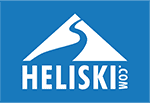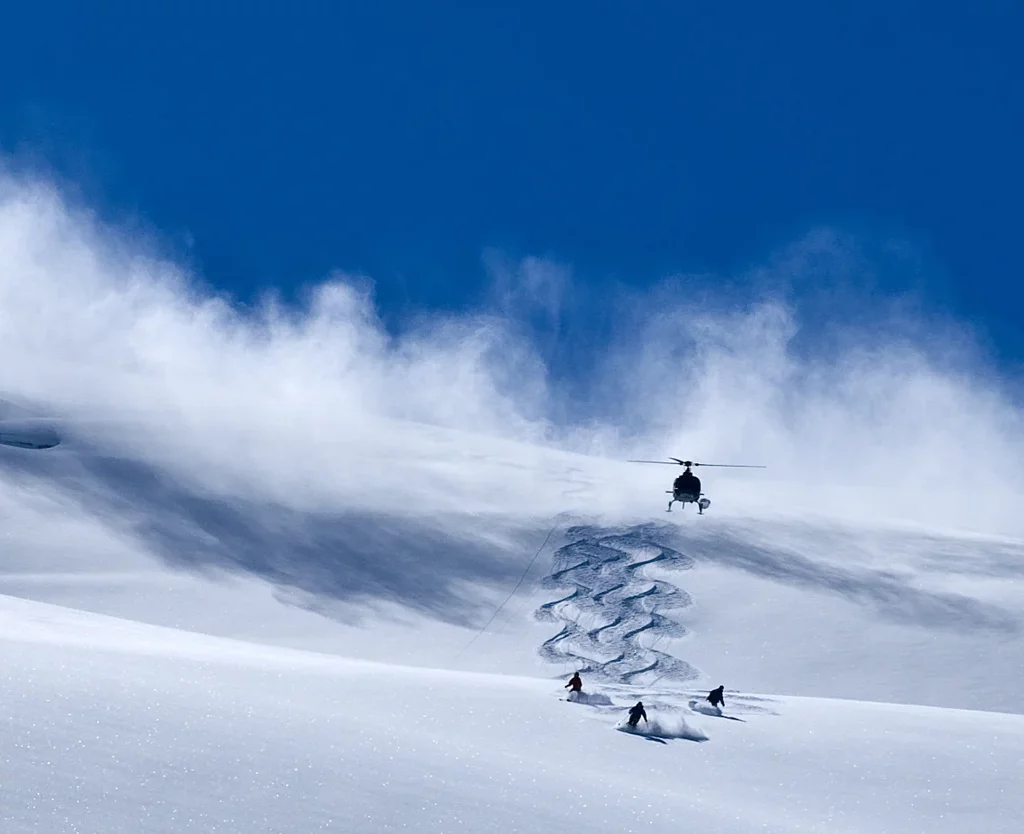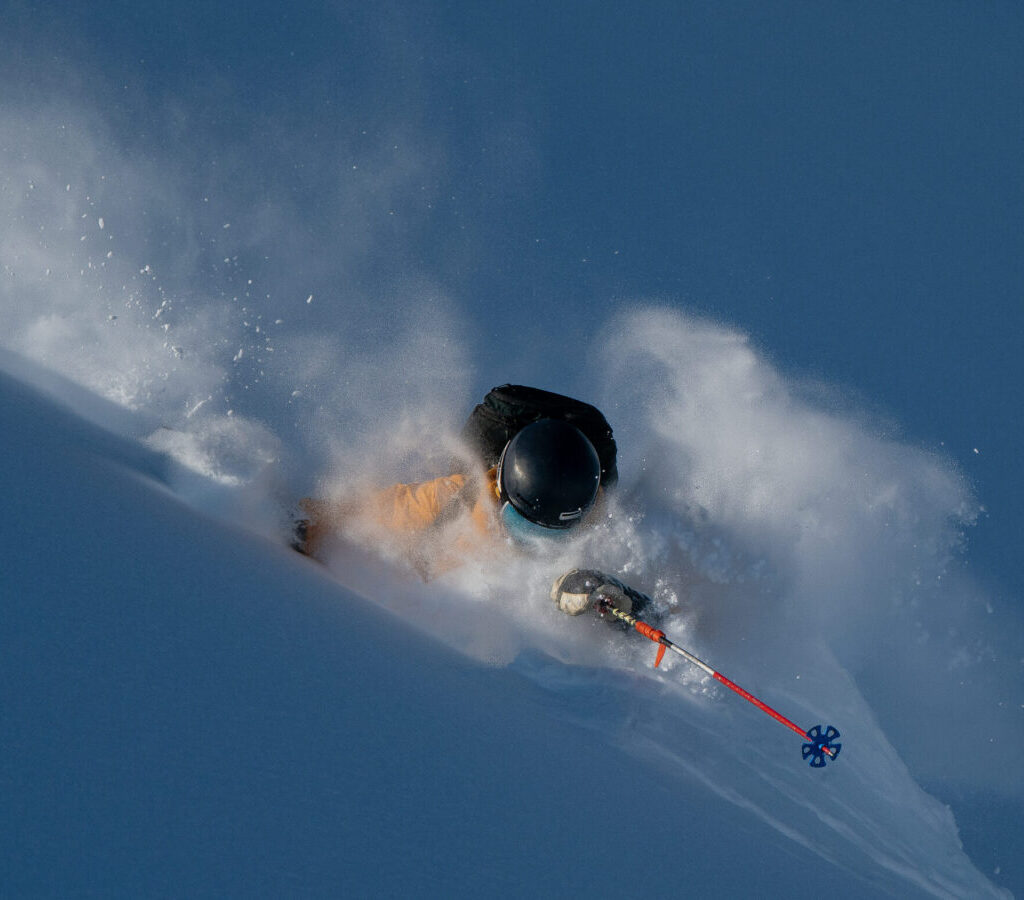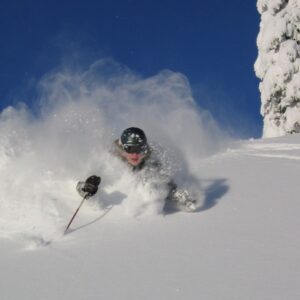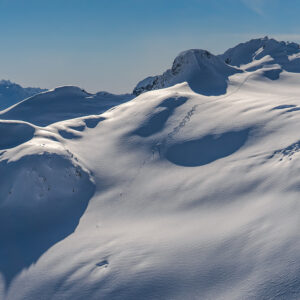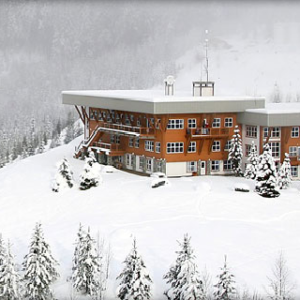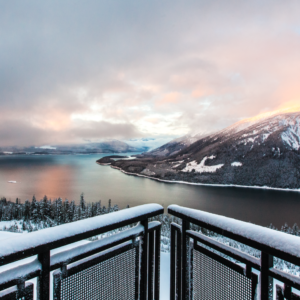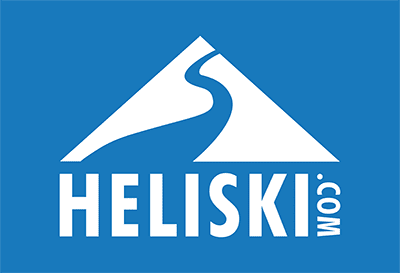Heli Skiing Canada
What is the perfect heliski trip for you and your friends? Imagine it…dream it…shape it some more in your head…then come to us and we will turn that dream into reality!
Our job creating your ideal trip involves working with every British Columbia heliskiing operator. So that means: more locations, more options, and therefore a pretty safe bet for you to have the trip of a lifetime! And did we mention that we’ve been doing this for longer than anyone else in the industry has? 25 years and more.
In conjunction with every British Columbia heli-ski operator, we curate custom heli-ski trips that are unique to your essential needs and wildest desires.
We cover absolutely everywhere in Canada and Alaska, so you’re bound to find something that fits the dream you have in mind.
How long have we been doing this you rightly ask? More than 25 years. So you can rest easy knowing we are industry experts.
What should you consider for your heliski trip?
Essential questions to ask yourself…
Our very own ‘Best Heliskiing Canada Bible’ is specifically designed to help you pick the very best option for your next heli-skiing trip.
How do we know you may ask? We have been doing this for over 25 years.
We have been conducting heliski surveys every year, so we have the input of thousands of heli-skiing clients just like you!
Heliskiing Canada with HELISKI.com
HELISKI.com has been heliskiing in Canada for over 25 years, and we have first-hand knowledge of all aspects of your heli-skiing trip. We can help you narrow down your choices and find the perfect destination for your needs.
Here are some of the factors to consider:
- The size of the group: Do you prefer an intimate heli-ski lodge with a small group of skiers, or do you want to be part of a larger group?
- The type of terrain: Do you prefer trees, bowls, glaciers, or a mix of all three?
- The amount of vertical: How many vertical feet do you want to ski each day?
- The timing of your trip: When do you want to go heliskiing in Canada?
- Your budget: How much are you willing to spend on your heli-skiing trip?
We can also help you with:
- Accommodation: We can recommend heli-ski lodges that match your budget and preferences.
- Transportation: We can arrange transportation to and from your heli-ski lodge.
- Guides: We can provide experienced guides who will ensure that you have a safe and enjoyable heli-skiing experience.
Contact us today to start planning your heli-skiing trip to Canada!
Here are some additional questions to ask yourself:
- Do you want to heliski in a remote location, or would you prefer to be closer to civilization?
- Do you want to have the option add catskiing or resort skiing before or after you heliskiing?
- Do you want to warm up at a resort before heliskiing?
The more information you can provide us, the better we can help you plan your perfect heli-skiing trip to Canada.
Why is heliskiing in BC the best in the world?
British Columbia, better known as BC, has quite simply the best heli-skiing in Canada. BC is in fact not just the best in heli-skiing in Canada, but the heli-skiing world. Why is it so coveted? Because it has the perfect combination of terrific terrain, a suitable climate and plentiful precipitation. Which is why it’s home to 90% of all global heliski and heliboard operations.
Contained within the vast province of British Columbia there are various regions – each with their own unique advantages and disadvantages. Snow quantity is directly affected by BC’s proximity to the Pacific ocean. Therefore typically, more snow falls on the Coastal Ranges.
Snow quality on the other hand is dependent on a range of factors. Most notably is how far north you venture (bringing colder temperatures), and how high you venture (the higher you go, the drier the snow).
For optimum heli-skiing, a good base level of snow is of course needed for both coverage and general stability. For this reason the vast majority of heli-skiing in Canada occurs in either the Interior Ranges or the Coastal Ranges. The Rockies on the other hand have less snowfall, and what falls is very dry snow. See a map of British Columbia Heli skiing and Heliboarding Locations.
We believe that all BC heli-skiing is quite simply, awesome! But all terrain is not created equal. Some locations are known for steep tree runs, others for wide open bowls and glaciers. Some locations offer very long runs, others do fast turnarounds. Many offer multiple locations and lodges, where the terrain differs significantly. It’s worth noting that the smaller your group, the more you can dictate the terrain you ski on.
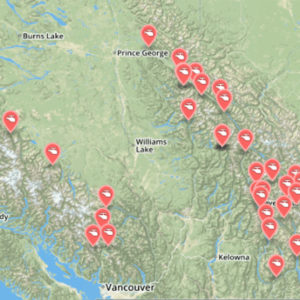
How does heli-skiing around the world compare?
Alaska Heliskiing is home of what is known as ‘the steep and the deep’. The season is typically later, and there is little tree skiing, compared to BC. The majority of operators work out of Valdez and the Haines area, but there are a couple of others. Alaska helicopter skiing is renowned for being fairly tricky to access and more down days. For example, more than a third of Anchorage to Valdez flights are canceled during the season. Unsurprisingly Alaska has far more non-skiable days than BC. Guests can only reliably plan to ski 4 out of 7 days, on average. Conditions are highly variable and it is STEEP. Which is why we don’t recommend going to Alaska on your first heliski trip.
Naturally, some options are better than others. The US offers heli-skiing and heliboarding in the ‘Lower 48’ as well. Utah, Colorado, Nevada, Washington, California and Idaho all have heli-skiing. Many of these are located at or near resort skiing, and cater for ‘one day trip bucket-listers’. Longer trips are also available from some.
European heli-skiing is somewhat restricted, starting late in season, and ending well before the end of the season. France has in fact outlawed it altogether. South America has some truly epic options. New Zealand also offers heli-skiing trips, but their safety standards vary. India, Russia, Greenland and Iceland are also viable locations for exotic heli adventures.
Here at heliski.com we are more than happy to help you find the best possible heli-skiing trip for your group – completely free!
The operators pay us a commission, and they take us to the best heli-skiing spots in Canada for free. You get a bespoke trip of a lifetime, we get to heliski for free – win win! 😀
When are the best times to heliski in BC, Canada?
British Columbia heli-skiing operates December to through April.
Primetime heliskiing is in February, but January and March are also very good. January and April can offer better deals though. Be aware that late season can include ‘corn snow’, in addition to, or instead of powder. Stability and weather are better later in the season. Stability issues, and lots of snow, means January is typically more tree skiing. January is colder, with of course less sunshine.
January vs. March Heli-Skiing
January Heli Skiing in Canada = Light Powder
Maybe the best kept secret in the industry. Most guides and operators will tell you this is their favorite skiing of the season.
Colder – So you may have to bundle up, but you may get drier, lighter powder
Short days – This can limit your vertical; which is especially bad if you are paying for unlimited vertical. It’s also worse the farther you go North. Alaska gets twice as much light at the end of their ‘season’ as they do in the beginning.
Snowpack /Coverage /Stability – Not usually a problem unless it’s a lean year, or you are very early in January. But as any tree skier knows, coverage matters.
Early season will have fewer boundary layers, but may also be relatively unsettled.
Price – early January and late March are the best BC heli-skiing deals going. Early April is a very good deal, and many operators would keep going later in the month if demand existed. The ‘prime’ weeks are now bleeding into late January and early March.
March Heli Skiing in Canada = Long Runs and High Alpine, including Bowls and Glaciated Terrain
Warmer – Sometimes too warm, but usually very comfortable. Too warm can make south-facing slopes ski like mashed potatoes.
Longer Days – Think huge vertical and tired legs. 40-45K vertical feet in a day is possible! If you choose Unlimited Vertical, you can really rack up the vert.
Coverage/Stability/Terrain – By March, most terrain is skiable. Some cornices may build up, but stability is usually very good. Spring heli-skiing in Canada usually includes a heavy dose of high alpine / glacier skiing. Runs so smooth and consistent that you may want to bring something to read…..kidding. I have counted 50 turns with my eyes closed, however.
Price – Not as cheap as January, but the later you go, the better the price.
Alaska heli-skiing has a much later season. Some operators open in February, but it’s better to wait. Prime time is March and April. Some will accommodate early May. It may be corn snow, however. There is twice as much sunlight at the end of the Alaska heli-skiing season than at the beginning.
What is the best BC Heli Skiing group size?
The size of the group and the number of groups per helicopter, or machine, are very important. Large operators like Canadian Mountain Holidays (CMH) and Mike Wiegele Helicopter Skiing use primarily big helicopters with 10-11 guests per lift/group. Nearly all of the boutique, smaller operators use A-stars, Bell407’s or the new Koalas. These hold just 4 to 6 guests at a time, and thus a more intimate experience.
In addition, smaller helicopters are more maneuverable. Small groups can access tighter areas that could not handle 13 sets of tracks. Smaller machines load and unload faster, reducing cycle time. However, the bigger machines such as the Bell212 are less expensive to operate and can offer economies of scale.
Groups per helicopter is another important criterion. One helicopter is easily capable of transporting one or two groups without any waiting around. Often even three groups can share a helicopter and avoid any waiting around. It’s worth noting that operators will attempt to group guests together of a similar ability and speed. This is due to the fact that a group is only as fast as the slowest skier (or boarder). The time spent waiting depends on the ‘weakest link’, and on the lead guide’s willingness and ability to leapfrog the slower group. This tricky situation can cause tension. This is exacerbated by groups that contain skiers of highly varied ability and/or speed. The group doing the passing is often anxious, and the group being passed gets irritated.
A common issue may arise too if some guests wish to do ‘extra vertical’ (for an additional cost); whereas others do not. Unless the lodge is close by, or there are appropriate groups, some guests can go away disappointed.
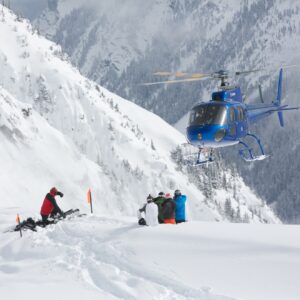
In an ideal world there would always be one group per helicopter, aka Private – a single helicopter for a single group – but it is expensive. Two groups per helicopter is much less expensive. Three groups per helicopter, classic or regular, is the industry norm for smaller, more boutique operations. The reality is that most operators are very skilled at managing the challenges of group dynamics.
What are the common BC Heli Skiing trip lengths?
Packages are available for 1, 2, 3, 4, 5, 6, 7 or more days. The most common lengths are 1-day, 4-day, 5-day and a ‘week’. Most ‘week’ trips are 7 nights with 6 full days of skiing. Some ski a full 7 days. An important distinction, eh? Some will offer skiing on the morning of departure. Some others can get you up on the snow the afternoon of the arrival day. Several companies now even offer a full seven days skiing, as they are located with easier access and guests can ski a full day on the last day (instead of using it as a change over day). But those are the exceptions.
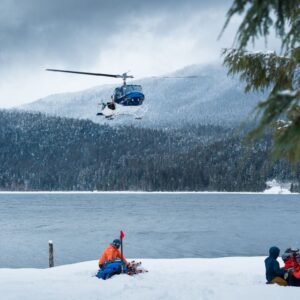
More remote operators can justify, and therefore accommodate, longer trips. A travel day at each end of the trip may be required, but as mentioned before, access is the key if you want to ski more and travel less. Therefore longer trips make the best use of time and money. Down days, unfortunately, do happen. If the helicopter cannot fly, due to weather or mechanical issues, the disappointment is magnified if it is a shorter trip. The number of down days per season varies greatly among operators. And it is not honestly reported. But we can help with that. A handful of operators now offer catskiing as a backup. It can save the day from being a complete washout, and is worth considering.
What is the travel options on your BC heli-skiing trip?
The total time taken for travel on a trip is a very important consideration. Some of the oldest operators require bus rides of 5-8 hours at both ends of the trip. This contrasts rather ironically with the very rapid and convenient service provided during the heli-skiing itself. And evidently this may not sit well at all with clients who can afford expensive heli-skiing trips.
It is advisable to obtain the travel itineraries for your entire group before you complete the booking. Getting to and from a Canadian heli-skiing destination can range from straightforward to rather challenging. Some locations are easily accessible with frequent ‘commuter’ flights. These are best to reserve in the fall, when they are on sale at surprisingly good prices. Some operators now include the commuter/charter flights from Vancouver airport. This is fantastic of course, and worth noting when doing your price comparisons.
The majority of operators utilize vans or buses for the last leg of the journey. The primary airports for heli-skiing access are Vancouver, Calgary and Anchorage – in that order. Many itineraries do require a singular night stay before or after the trip, some both. Some operators include this in the price, others do not. A few operators that have easy access to the locations, offer West Coast guests to get to their lodge on the first day. It may even be possible to ski the morning of the last day; which is a big bonus!
Several operators offer easy access with all the same feelings of remoteness without the additional travel time. Another benefit to easy access is that it may also increase the skiing time you have available during your package. This is known to add a full day to a package in some cases.
What does it cost to go heli-skiing in BC, Canada?
Is Unlimited Vertical worth it?
Heli-skiing is expensive. The good news is that it is worth it. Most packages run $1,500 to $2,000 Canadian per day. This will include: food, lodging, helicopter travel, equipment and guides. Equipment includes: safety equipment (avalanche pack, shovel, probe and avalanche beacon), skis and poles. Alcohol and massages usually incur an additional cost.
Most packages include a guaranteed minimum vertical (amount of vertical feet you will ski on the trip). Additional vertical is typically $40-60 CAD per thousand feet. Extra runs are $100-150 CAD. The operator will require a minimum number of skiers to agree to the extra vertical, in order to make it cost effective for them. It’s common for groups to be reconfigured late in the day, to allow one or two groups to go for that extra vertical. While the remainder head back to the lodge for a head start on the hors d’oeuvres, cocktails and hot tub.
If bad weather or mechanical problems occur that prevent you from reaching the guaranteed minimum, most operators will issue a credit toward a future trip. It is unusual to get a refund. Operators vary widely on their willingness to accommodate clients for missed vertical.
Some packages include unlimited vertical for a fixed price. Unlimited vertical appeals to those who appreciate certainty, want to ski like hell, or both. Some offer it during off peak only. We can help you decide if it’s worth it for your trip, including the break-even point where unlimited is a better deal. On average, for a 7-day trip, it’s around 120,000 vertical feet. Below is my blog post on the pros and cons of unlimited heli-skiing.
These operators offer unlimited vertical on every package:
Bearpaw Heliskiing
Eagle Pass Heli Skiing
Eleven / Kingfisher Heli Skiing
Great Bear Heli Skiing
Great Canadian Heli Skiing
Mica Heli Skiing
Mike Wiegele Helicopter Skiing
Northern Escape Heli Skiing (Option)
Selkirk Tangiers Heli Skiing (Early Season)
Silvertip Snowwater
Skeena Helisking
Stellar Heli Skiing
Tyax Lodge & Heli Skiing
White Wilderness
There is no stressing over how much you have skied, and no surprises at checkout (other than your bar tab). Proponents appreciate that there is no stress about racking up the vertical throughout the week; and no $1-3K bill at checkout. Northern Escape Heli Skiing now offers unlimited vertical as an option, for a higher base rate.
Detractors point out that unlimited vertical lacks goal congruence with the operator. The hourly expense of the helicopter provides a huge economic incentive for operators to shorten the day. Some think it may tempt operators to call a finish to the day early, take a longer lunch, start later, or even to call a ‘down day’ earlier than necessary.
Operators who offer a base price with charges for extra vertical like to make the valid point that paying in advance for unlimited vertical can be very expensive if you don’t have a great week. It can result in a much higher price per run, or per vertical foot. For some, the break-even point is just over 100,000 feet. While at others it can be over 200,000 vertical feet in a week. Prices and extra vertical fees vary.
Another consideration is the date of the trip. Unlimited vertical in Northern British Columbia in January is limited by the hours of daylight. And conversely, unlimited Alaska heli-skiing in April could go on for 16 hours…..
We encourage clients to do the math before booking (or just ask us at HELISKI.com to do it for you!) These minimum and extra vertical fees vary significantly. Not to mention the math involved to convert currency and meters vs. feet.
Let us know if we can help. Simply call: 866-HELISKI
What are the lodges like when Heli Skiing in BC, Canada?
Most BC Heliskiing Operators offer very nice lodges in remote locations. A few offer less expensive options, especially those that cater to day-trippers. Most will offer excellent amenities, including: bar, hot tub, wireless internet, ski shop, massage, gym, TV/movies and so on. Check them out online. Most are pretty great and luxurious!
Some accommodations are in fact fishing lodges in the summer months. Lodging is in hotels at a handful of locations.
Accommodation in Alaska is considerably more ‘rugged’ shall we say, with a couple of exceptions. The center of gravity is Valdez. Most operators shuttle clients back and forth from their motel in Valdez. A few have their own accommodations. Another interesting option in Alaska, is a motor home. The operators make it easy to hook up and hang out when you are skiing, and go exploring when you are not. You have the option of cooking for yourself, too. In general, Alaska is far less luxurious, to say the least.
Down days due to weather or equipment failure, do happen. Good down day (quite the oxymoron!) activities include: ski touring, cat skiing, resort skiing, fishing, snowmobiling, sea kayaking and more.
The food is almost always awesome! Destination heli-skiing operators almost all offer great food! Guides complain of what is known as ‘Heli Belly’. Needless to say, many guests actually gain weight on their trips! Hotel based operations may be a little less gourmet. Some of the bigger operators do buffet style, but the food is still fantastic.
What helicopters are used for Heli Skiing in BC?
There are several helicopters common in the heli-skiing industry. The heli-skiing industry naturally has a few go to helicopters that most operators use. Most popular with boutique operators is the ‘A-Star’. It typically carries four guests across a bench-like seat in the back; with the pilot and guide in the front. It is also known as the ‘A-Star B’; which includes models ‘B2’ and the more powerful ‘B3’. Getting in and out of these machines is very easy. They are very maneuverable, and fast.
The ‘Bell 205’, ‘206’ and ‘212’ carry up to eleven guests, a guide and a pilot. Operators may run two, three or even four groups per helicopter. There are trade-offs of course though. Bigger helicopters have longer load and unload time, and clients ski in larger groups. This can be an issue, as some terrain does not lend itself well to 12-48 tracks. The ‘Bell 407’ typically seats five in the rear; the pilot and one more sit up front (which is usually the guide with the exception of the last ride home). The Koala carries 6 guests, a guide and the pilot.
Operators with smaller helicopters and groups have more flexibility in arranging groups, reaching terrain, etc. Most will run three small groups per helicopter. The exception is Private or Semi Private packages that run one or two groups respectively. The price is higher, but the experience is the best. With 7 or more in a group, a private may be the best deal.
Am I good enough to go Heli Skiing in BC?
Requirements for skiing ability vary somewhat. The resort-based and one-day oriented operators suggest ‘intermediate’ ability is required and/or ‘some powder experience.’ The more remote operators suggest ‘strong intermediate’ ability or ‘able to ski any run at a resort in control.’ We feel it important to stress that while they say this, these are definitely minimum requirements. Most clients will be of an expert ability, with good powder skiing ability. We discourage you from inviting a buddy with marginal ability if you want to ski fast and make friends in the lodge.
The other requirement for a heliski trip is ‘good physical condition.’ It is very important to be in good shape. You do not want to be straining to keep up. Worse, you do not want to be slowing down your friends (and perhaps now former friends). Get yourself in very good shape to heliski! We promise you’ll be glad you did.
How am I and my group kept safe on our trip?
Safety and Guides
Most operators are members of the HeliCat Canada Association. They require strict standards from its members, ensuring that they meet them through standard audits of their operating procedures. A handful of other companies, most notably Mike Wiegele, have their own standards and training. This is important to note, as there are currently no government regulations for guides in Canada. The good news is that they have been very successful at self-regulation, and have a very good safety record to date.
One of the important points to consider is Guides qualifications. HeliCat Canada <links> recognizes only ACMG (Association of Canadian Mountain Guides) and the IFMGA (International Federation of Mountain Guide’s Associations) of which the ACMG is the Canadian member. There are many other training schools in Canada, but none, other than the ACMG are internationally recognized.
All operators share snow condition and avalanche threat information daily on a common network. This allows guides to select the slopes with the most stable aspects and pitches.
What are the safety protocols on a Heli Skiing Canada trip?
On the first day of a heli-skiing trip, clients receive detailed safety briefing and training. Some include video and/or slides, as well as ‘on the snow’ training. Among the most important topics are backcountry risks, and how to ameliorate them. This includes how to recognize and reduce avalanche threats. Avalanche procedures are explained and practiced. This includes training and practice with avalanche beacons.
Guests learn how to wear, operate and charge avalanche beacons. Guides will check to make sure all beacons are set to ‘send’ a signal and ensure you’re found (in a worst case scenario). In the event of an avalanche, everyone in the group turns their beacon from ‘send’ to ‘receive’, which is extremely important. Then the systematic search protocol is explained and practiced. Guides bury a beacon and the group practices search and recovery in a controlled outdoor setting. Most importantly, make sure the others in your group pay attention, as they will be the ones digging you out!
Most operators now provide avalanche airbag systems. In the event of an avalanche, these devices significantly decrease the chances of being buried.
Use of probes, shovels and radios is part of the training as well. Typically all of these will be carried in the backpack of every client. That is a good place for an extra pair of gloves, goggles, neck gaiter, and maybe a thin vest as an extra layer if needed.
Finally, guests learn how to act in and around the helicopter. Loading and unloading procedures are explained. Listen carefully to the ‘do’s and don’ts’ for the safety and enjoyment of everyone. Every guest needs to know the location of emergency equipment, and how to use it correctly and quickly.
Guides begin their day with safety reviews and forecasts. Heliski operators share data on snow conditions and stability. Guides combine this information with detailed weather and avalanche forecasts. This information is used to formulate plans for the day, including what aspects and slopes offer the safest and best skiing, and which to avoid. Throughout the day, guides continuously monitor snow conditions, including digging pits to check for depth and stability of snow layers. They may seem relaxed and casual, but the guides are constantly evaluating risks, and how to minimize them. Which is of course rather reassuring!
Heli Skiing Trip Insurance is a good idea. It covers injuries before your trip and travel problems, as well as during the trip itself. We do strongly recommend trip cancellation/disruption insurance. It is an add-on to the package price when guests make their final payment. It’s about $300 US, but varies by the trip length and the age of the guest.
Evacuation insurance is usually included, but some charge a modest fee.
Why ask us for advice for your heliski trip?
HELISKI.com offers impartial, objective advice and gives recommendations that are based on personal experience. And it’s completely free!
The heli-skiing operator pays us (and they take TJ heli-skiing for free!)
Contact details:
www.HELISKI.com
Call: 866-HELISKI (866-435-4754)
International: +1 925-683-7676
Email: tj@HELISKI.com
